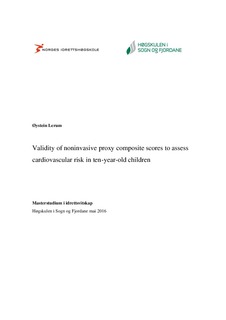| dc.contributor.author | Lerum, Øystein | |
| dc.date.accessioned | 2017-08-15T11:58:34Z | |
| dc.date.available | 2017-08-15T11:58:34Z | |
| dc.date.issued | 2016 | |
| dc.identifier.uri | http://hdl.handle.net/11250/2450779 | |
| dc.description | Masterstudium i idrettsvitskap Høgskulen i Sogn og Fjordane mai 2016. Del 2 av oppgaven senere publisert i Scandinavian Journal of Medicine & Science in Sports: Lerum, Ø., Aadland, E., Andersen, L. B., Anderssen, S. A., & Resaland, G. K. (2017). Validity of noninvasive composite scores to assess cardiovascular risk in 10-year-old children. Scandinavian Journal of Medicine & Science in Sports, 27(8), 865-872. doi: 10.1111/sms.12826 | nb_NO |
| dc.description.abstract | Aim: Evaluate the validity of six noninvasive scores by: 1) determining the agreement between noninvasive scores and a complete cardiovascular disease (CVD) risk score, and 2) examining the ability of these noninvasive scores to correctly classify children with elevated risk.
Methods: Cross-sectional data from 911 ten-year-old Norwegian children. A complete CVD risk factor score (triglyceride, total cholesterol/HDL ratio, homeostasis model assessment of insulin resistance, systolic blood pressure [SBP], waist-to-height ratio and cardiorespiratory fitness) and six noninvasive scores (fitness + three different measures of fatness, with and without inclusion of SBP) was calculated (mean z-score) by gender. Agreement was assessed using Bland-Altman plots. The ability of noninvasive scores to correctly classify children with clustered CVD risk was examined using Receiver Operating Characteristic (ROC) analysis.
Results: For both sexes the noninvasive scores without SBP showed significant correlation (r = >0.75, r2 = >0.56, all p<0.001) and excellent area under the curve (AUC) values (>0.92, 95% CI = 0.89-0.97). Inclusion of SBP increased the validity of the score by narrower limits of agreement ((0.0 ± 0.73-0.80 (arbitrary unit) vs. 0.0 ± 1.06-1.11)) and substantially decreased proportional bias (boys: β = -0.12, p<0.001 vs. β = -0.36, p<0.001; girls: β = -0.07, p = 0.013 vs. β = -0.30, p<0.001).
Conclusion: Noninvasive scores including fitness and fatness provided acceptable agreement and classification accuracy, allowing for early identification of children that might be at risk for developing CVD later in life. SBP should be included in the noninvasive scores to avoid misclassification of high-risk children.
Keywords: Anthropometric measures, cardiorespiratory fitness, cardiovascular disease risk factors, systolic blood pressure, noninvasive proxy composite risk factor score | nb_NO |
| dc.language.iso | eng | nb_NO |
| dc.relation.haspart | Introduksjons- og metodekapittel samt artikkel: Validity of noninvasive proxy composite scores to assess cardiovascular risk in ten-year-old children | nb_NO |
| dc.subject | Hjerte- og karsjukdommar | nb_NO |
| dc.subject | ikkje-invasiv risiko score | nb_NO |
| dc.subject | antropometriske variablar | nb_NO |
| dc.subject | kardiorespiratorisk fitness | nb_NO |
| dc.subject | systolisk blodtrykk | nb_NO |
| dc.subject | barn | nb_NO |
| dc.title | Validity of noninvasive proxy composite scores to assess cardiovascular risk in ten-year-old children | nb_NO |
| dc.title.alternative | Gyldigheit av ikkje invasiv proxy samansette score for å vurdere risiko for å vurdere kardiovaskulær risiko i ti år gamle barn | nb_NO |
| dc.type | Master thesis | nb_NO |
